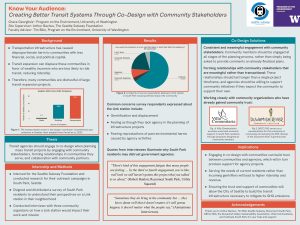Know Your Audience: Creating Better Transit Systems through Co-Design with Community Stakeholders
The looming threat of global climate change has intensified scrutiny of our nation’s transportation infrastructure, which is the largest contributor to carbon emissions. Expanding mass transit systems could be key to reducing these emissions, yet many individuals are distrustful of large transit agencies, fearing that their needs and the unique characteristics of their communities will be overlooked in the planning process. While transit agencies possess the technical expertise necessary for designing transit systems, grassroots organizations are better equipped to understand the social context of the communities they serve and can effectively build trust among local residents. By engaging in co-design with community stakeholders, transit planners can foster collaboration that addresses the distinct needs of these communities and create a more effective transit system in the process. This study aims to explore the perspectives of South Park, Seattle residents around a Link light rail station in their neighborhood. I conducted three interviews with community organizers and distributed a survey that received nearly 90 responses in one month. The results revealed that a majority of participants supported the addition of a Link station in South Park, but many expressed concerns about potential gentrification, displacement, and changes in community character. My findings underscore the importance of proactive outreach to communities sited for future transit projects and collaboration with local grassroots organizations. By collaborating with these organizations, transit planners can create systems that serve the community’s needs and get people out of their cars and onto mass transit.
